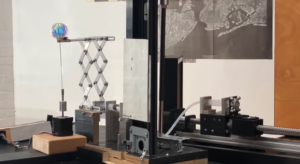Mary Sherman
In Lewis Carroll’s book Sylvie and Bruno, the inhabitants in Wonderland make an ingenious map – a 1:1 scale map of the world. But as one of characters notes, it was a bit impractical, so “we now use the country itself, as its own map, and I assure you it does nearly as well.”
Carroll’s story is the inspiration for Wonderland, a visual, aural and kinetic cautionary tale. The installation Wonderlandsuggests a future when nature has been replaced by machines and computers. A fake irrigation system (powered by water pumped between syringes and controlled by a microprocessor) pushes strips of plastic upwards into the air. From there, a fake sun (made out of lightbulbs) power a solar cell, which causes the strips to spin and coalesce into the shape of a flower. As (hopefully) delightful as the piece is, one still wishes that humanity – like Carroll’s characters – will realize that a real flower is infinity more wondrous and start to take better care of the multi-sensory marvels nature offers with just the mere planting of a seed. Germane to this Conference, is also the delayed use of sound (i.e. Roger’s Doyle’s musical composition The Blue Line to Wonderland). Think, for instance, of how long the piece would hold your interest without its accompanying soundtrack (which is an integral part of the piece, broadcast through the map on the wall).
Installation: Variable
Includes:
Main Structure: 21”x 55” x 30”, micro-processors, aluminum, wood, motors, electronics, oil on board. (Note: A wall-mounted button starts the piece).
The “Flower” (powered by the “Sun” and “Water”): 11.5”x3”x3”, plastic strips, motor, aluminum.
The “Sun”: 50” x13”x13”, LED light bulbs, aluminum, solar panel.
The “Water”: pumped between 2 syringes.
The “Earth”: 51”x 55”x 2”, Maps of New York Planning Commission’s 1969 proposal for Staten Island (scale: 1”:1 mile), including a framed map detail (which serves as the audio/speaker membrane that broadcasts Doyle’s composition).
Video Link: https://vimeo.com/1055036262?share=copy#t=0


